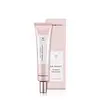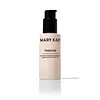What's inside
What's inside
 Key Ingredients
Key Ingredients

 Benefits
Benefits

 Concerns
Concerns

 Ingredients Side-by-side
Ingredients Side-by-side

Water
Skin ConditioningCyclopentasiloxane
EmollientGlycerin
HumectantEthylhexyl Methoxycinnamate
UV AbsorberEthylhexyl Salicylate
UV AbsorberAlcohol
AntimicrobialCaprylic/Capric Triglyceride
MaskingIsoamyl P-Methoxycinnamate
UV AbsorberNiacinamide
SmoothingDiethylamino Hydroxybenzoyl Hexyl Benzoate
UV FilterMica
Cosmetic ColorantButyrospermum Parkii Butter
Skin ConditioningDimethicone
EmollientTitanium Dioxide
Cosmetic ColorantPolysorbate 60
Emulsifying1,2-Hexanediol
Skin ConditioningSilica
AbrasivePEG-100 Stearate
Cetearyl Alcohol
EmollientPhenoxyethanol
PreservativeBeeswax
Emulsion StabilisingAmmonium Acryloyldimethyltaurate/Vp Copolymer
Hydroxyethyl Acrylate/Sodium Acryloyldimethyl Taurate Copolymer
Emulsion StabilisingStearic Acid
CleansingParfum
MaskingPortulaca Oleracea Extract
Skin ConditioningTocopheryl Acetate
AntioxidantSodium Acrylate/Sodium Acryloyldimethyl Taurate Copolymer
Emulsion StabilisingXanthan Gum
EmulsifyingPolyurethane-11
Adenosine
Skin ConditioningTriethoxycaprylylsilane
Isohexadecane
EmollientButylene Glycol
HumectantDisodium EDTA
Polysorbate 80
EmulsifyingTin Oxide
AbrasiveCI 14700
Cosmetic ColorantEthylhexylglycerin
Skin ConditioningPlukenetia Volubilis Seed Oil
EmollientCitric Acid
BufferingAloe Barbadensis Leaf Extract
EmollientAlthaea Rosea Flower Extract
Skin ConditioningNelumbo Nucifera Flower Water
TonicWater, Cyclopentasiloxane, Glycerin, Ethylhexyl Methoxycinnamate, Ethylhexyl Salicylate, Alcohol, Caprylic/Capric Triglyceride, Isoamyl P-Methoxycinnamate, Niacinamide, Diethylamino Hydroxybenzoyl Hexyl Benzoate, Mica, Butyrospermum Parkii Butter, Dimethicone, Titanium Dioxide, Polysorbate 60, 1,2-Hexanediol, Silica, PEG-100 Stearate, Cetearyl Alcohol, Phenoxyethanol, Beeswax, Ammonium Acryloyldimethyltaurate/Vp Copolymer, Hydroxyethyl Acrylate/Sodium Acryloyldimethyl Taurate Copolymer, Stearic Acid, Parfum, Portulaca Oleracea Extract, Tocopheryl Acetate, Sodium Acrylate/Sodium Acryloyldimethyl Taurate Copolymer, Xanthan Gum, Polyurethane-11, Adenosine, Triethoxycaprylylsilane, Isohexadecane, Butylene Glycol, Disodium EDTA, Polysorbate 80, Tin Oxide, CI 14700, Ethylhexylglycerin, Plukenetia Volubilis Seed Oil, Citric Acid, Aloe Barbadensis Leaf Extract, Althaea Rosea Flower Extract, Nelumbo Nucifera Flower Water
Water
Skin ConditioningPropanediol
SolventGlycerin
HumectantSilica
AbrasiveCaprylyl Methicone
Skin ConditioningCeteareth-25
CleansingAluminum Starch Octenylsuccinate
AbsorbentAmmonium Acryloyldimethyltaurate/Vp Copolymer
Beeswax
Emulsion StabilisingGlyceryl Stearate
EmollientNiacinamide
SmoothingDimethicone
EmollientPhenoxyethanol
PreservativeDisodium Ethylene Dicocamide PEG-15 Disulfate
CleansingVp/Eicosene Copolymer
Hydroxyacetophenone
AntioxidantOpuntia Ficus-Indica Fruit Extract
Skin ConditioningXanthan Gum
EmulsifyingDisodium EDTA
Ethylhexylglycerin
Skin ConditioningSaccharomyces Cerevisiae Extract
Skin ConditioningSucrose Stearate
EmollientAlcohol
AntimicrobialDipropylene Glycol
HumectantEthyl Macadamiate
Skin ConditioningResveratrol
AntioxidantSodium Benzoate
MaskingTocopheryl Acetate
AntioxidantOligopeptide-1
Skin ConditioningWater, Propanediol, Glycerin, Silica, Caprylyl Methicone, Ceteareth-25, Aluminum Starch Octenylsuccinate, Ammonium Acryloyldimethyltaurate/Vp Copolymer, Beeswax, Glyceryl Stearate, Niacinamide, Dimethicone, Phenoxyethanol, Disodium Ethylene Dicocamide PEG-15 Disulfate, Vp/Eicosene Copolymer, Hydroxyacetophenone, Opuntia Ficus-Indica Fruit Extract, Xanthan Gum, Disodium EDTA, Ethylhexylglycerin, Saccharomyces Cerevisiae Extract, Sucrose Stearate, Alcohol, Dipropylene Glycol, Ethyl Macadamiate, Resveratrol, Sodium Benzoate, Tocopheryl Acetate, Oligopeptide-1
Ingredients Explained
These ingredients are found in both products.
Ingredients higher up in an ingredient list are typically present in a larger amount.
Alcohol comes in many different forms. Different types of alcohol will have different effects on skin. This ingredient is usually an astringent alcohol.
These alcohols are drying on the skin. They may strip away your skin's natural oils and even damage your skin barrier. Astringent alcohols may also irritate skin.
Other types of astringent alcohols include:
According to the National Rosacea Society based in the US, you should be mindful of products with these alcohols in the top half of ingredients.
Any type of sanitizing product will have high amounts of alcohol to help kill bacteria and viruses.
Fatty alcohols come from plant oils such as coconut oil. These can help hydrate the skin and are non-irritating. Some fatty alcohols include cetyl and stearyl alcohol.
Learn more about AlcoholAmmonium Acryloyldimethyltaurate/Vp Copolymer (let's call it AAVC for short) is a synthetically created polymer. It's used as a film-forming agent and used to thicken the consistency of products.
AAVC is able to increase the consistency and viscosity of products due to its large molecule size. It also prevents ingredients from separating.
Beeswax is natural wax produced by honey bees and can be synthetically created. It consists mainly of fatty acid esters and long-chain alcohols.
In cosmetics, beeswax is a emollient. Due to its waxy structure, it creates a protective barrier. This barrier prevents water from evaporating off the skin.
This may not be a good ingredient for oily skin. We recommend speaking with a professional if you have concerns.
Beeswax cannot be removed with water, but can be taken off with an oil cleanser.
Beeswax is also antiseptic and contains vitamin A.
Learn more about BeeswaxDimethicone is a type of synthetic silicone created from natural materials such as quartz.
What it does:
Dimethicone comes in different viscosities:
Depending on the viscosity, dimethicone has different properties.
Ingredients lists don't always show which type is used, so we recommend reaching out to the brand if you have questions about the viscosity.
This ingredient is unlikely to cause irritation because it does not get absorbed into skin. However, people with silicone allergies should be careful about using this ingredient.
Note: Dimethicone may contribute to pilling. This is because it is not oil or water soluble, so pilling may occur when layered with products. When mixed with heavy oils in a formula, the outcome is also quite greasy.
Learn more about DimethiconeDisodium EDTA plays a role in making products more stable by aiding other preservatives.
It is a chelating agent, meaning it neutralizes metal ions that may be found in a product.
Disodium EDTA is a salt of edetic acid and is found to be safe in cosmetic ingredients.
Learn more about Disodium EDTAEthylhexylglycerin (we can't pronounce this either) is commonly used as a preservative and skin softener. It is derived from glyceryl.
You might see Ethylhexylglycerin often paired with other preservatives such as phenoxyethanol. Ethylhexylglycerin has been found to increase the effectiveness of these other preservatives.
Glycerin is already naturally found in your skin. It helps moisturize and protect your skin.
A study from 2016 found glycerin to be more effective as a humectant than AHAs and hyaluronic acid.
As a humectant, it helps the skin stay hydrated by pulling moisture to your skin. The low molecular weight of glycerin allows it to pull moisture into the deeper layers of your skin.
Hydrated skin improves your skin barrier; Your skin barrier helps protect against irritants and bacteria.
Glycerin has also been found to have antimicrobial and antiviral properties. Due to these properties, glycerin is often used in wound and burn treatments.
In cosmetics, glycerin is usually derived from plants such as soybean or palm. However, it can also be sourced from animals, such as tallow or animal fat.
This ingredient is organic, colorless, odorless, and non-toxic.
Glycerin is the name for this ingredient in American English. British English uses Glycerol/Glycerine.
Learn more about GlycerinNiacinamide is a multitasking form of vitamin B3 that strengthens the skin barrier, reduces pores and dark spots, regulates oil, and improves signs of aging.
And the best part? It's gentle and well-tolerated by most skin types, including sensitive and reactive skin.
You might have heard of "niacin flush", or the reddening of skin that causes itchiness. Niacinamide has not been found to cause this.
In very rare cases, some individuals may not be able to tolerate niacinamide at all or experience an allergic reaction to it.
If you are experiencing flaking, irritation, and dryness with this ingredient, be sure to double check all your products as this ingredient can be found in all categories of skincare.
When incorporating niacinamide into your routine, look out for concentration amounts. Typically, 5% niacinamide provides benefits such as fading dark spots. However, if you have sensitive skin, it is better to begin with a smaller concentration.
When you apply niacinamide to your skin, your body converts it into nicotinamide adenine dinucleotide (NAD). NAD is an essential coenzyme that is already found in your cells as "fuel" and powers countless biological processes.
In your skin, NAD helps repair cell damage, produce new healthy cells, support collagen production, strengthen the skin barrier, and fight environmental stressors (like UV and pollution).
Our natural NAD levels start to decline with age, leading to slower skin repair, visible aging, and a weaker skin barrier. By providing your skin niacinamide, you're recharging your skin's NAD levels. This leads to stronger, healthier, and younger looking skin.
Another name for vitamin B3 is nicotinamide. This vitamin is water-soluble and our bodies don't store it. We obtain Vitamin B3 from either food or skincare. Meat, fish, wheat, yeast, and leafy greens contain vitamin B3.
The type of niacinamide used in skincare is synthetically created.
Learn more about NiacinamidePhenoxyethanol is a preservative that has germicide, antimicrobial, and aromatic properties. Studies show that phenoxyethanol can prevent microbial growth. By itself, it has a scent that is similar to that of a rose.
It's often used in formulations along with Caprylyl Glycol to preserve the shelf life of products.
Silica, also known as silicon dioxide, is a naturally occurring mineral. It is used as a fine, spherical, and porous powder in cosmetics.
Though it has exfoliant properties, the function of silica varies depending on the product.
The unique structure of silica enhances the spreadability and adds smoothness, making it a great texture enhancer.
It is also used as an active carrier, emulsifier, and mattifier due to its ability to absorb excess oil.
In some products, tiny microneedles called spicules are made from silica or hydrolyzed sponge. When you rub them in, they lightly polish away dead skin layers and enhance the penetration of active ingredients.
Learn more about SilicaTocopheryl Acetate is AKA Vitamin E. It is an antioxidant and protects your skin from free radicals. Free radicals damage the skin by breaking down collagen.
One study found using Tocopheryl Acetate with Vitamin C decreased the number of sunburned cells.
Tocopheryl Acetate is commonly found in both skincare and dietary supplements.
Learn more about Tocopheryl AcetateWater. It's the most common cosmetic ingredient of all. You'll usually see it at the top of ingredient lists, meaning that it makes up the largest part of the product.
So why is it so popular? Water most often acts as a solvent - this means that it helps dissolve other ingredients into the formulation.
You'll also recognize water as that liquid we all need to stay alive. If you see this, drink a glass of water. Stay hydrated!
Learn more about WaterXanthan gum is used as a stabilizer and thickener within cosmetic products. It helps give products a sticky, thick feeling - preventing them from being too runny.
On the technical side of things, xanthan gum is a polysaccharide - a combination consisting of multiple sugar molecules bonded together.
Xanthan gum is a pretty common and great ingredient. It is a natural, non-toxic, non-irritating ingredient that is also commonly used in food products.
Learn more about Xanthan Gum